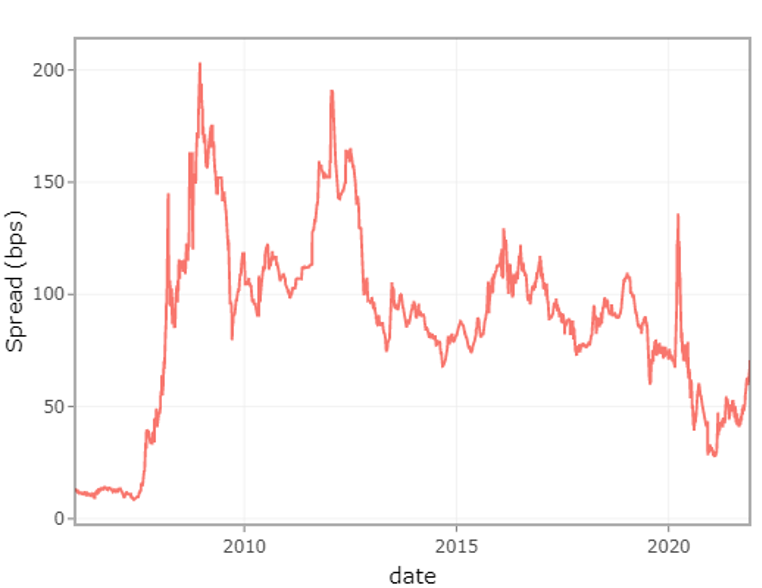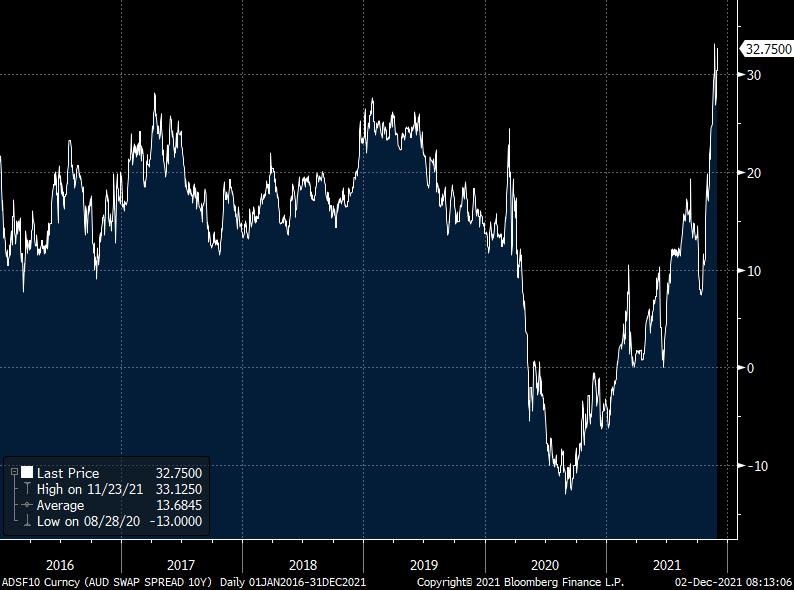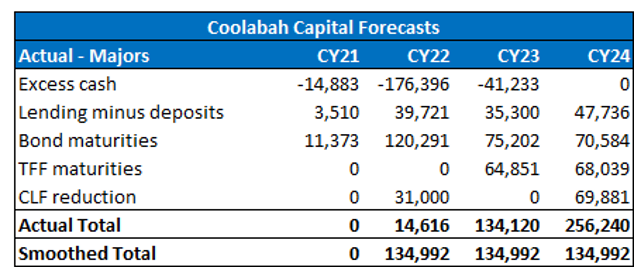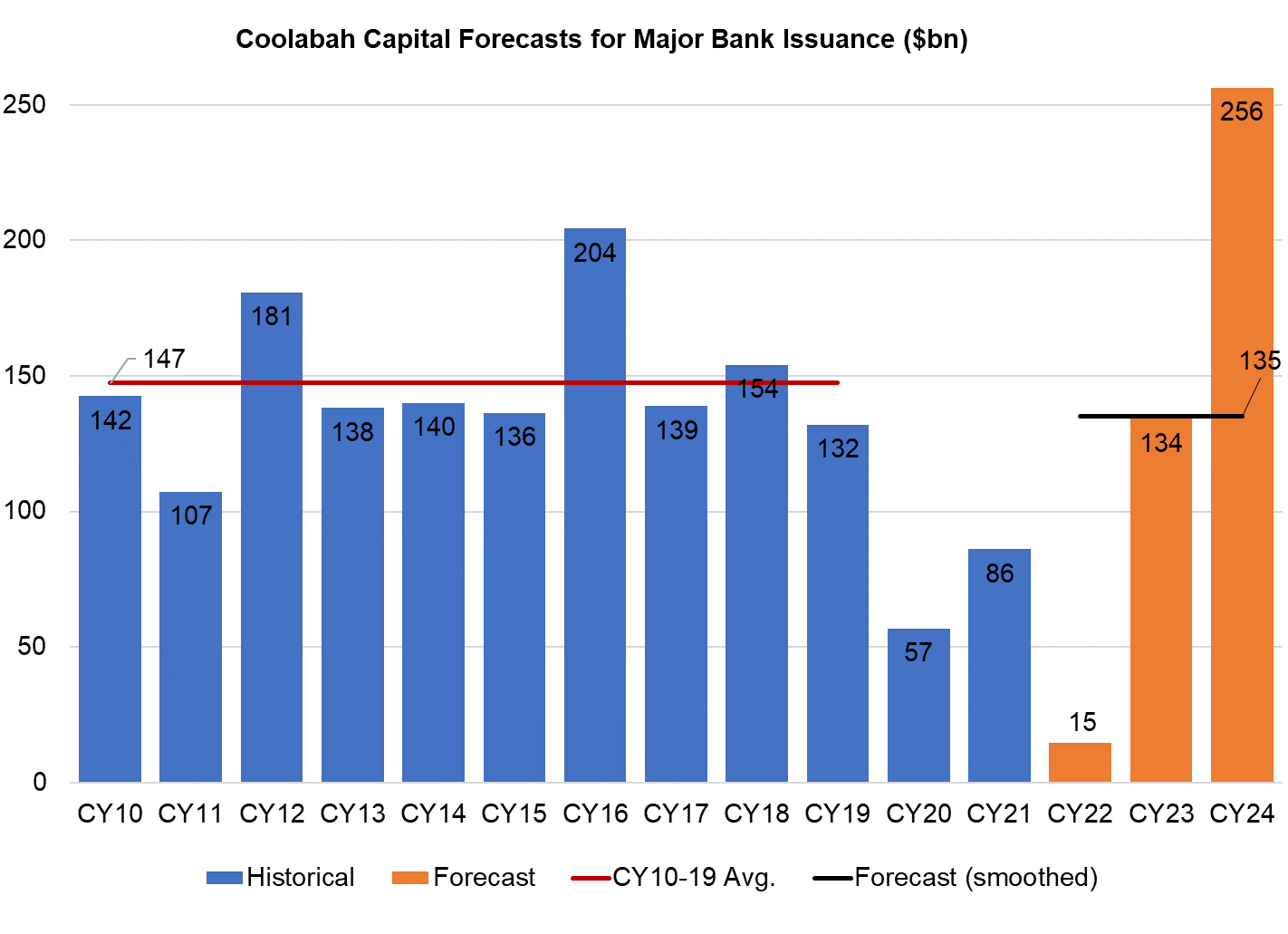Updated major bank funding task: falls to $135bn pa (vs 10yr av. of $147bn pa)
Following APRA's release of its October Monthly Authorised Deposit-taking Institution Statistics, we have updated our estimates of the four major banks' debt funding task over the next few years. As a result of deposit growth continuing to outstrip new lending, the big banks' funding gap has compressed. We currently estimate they need to issue about $135bn pa, on average, over the next three calendar years, which compares favourably to the $147bn pa they issued on average over the 10-years prior to the COVID-19 shock. (This $135bn pa task is a little less than our $143bn pa previous estimate.) And funding needs are really back-ended into CY2023 and CY2024.
All of the above suggests that the major banks' credit spreads will remain historically quite tight (ie, their funding costs should be low), although they will be higher than the unusually attractive levels recorded after the COVID-19 shock as banks stopped issuing wholesale debt and replaced it with funding borrowed from the RBA.
The major banks' 5-year senior bond spreads have already normalised back into the lower-end of their pre-COVID and post-GFC range (ie, much of the spread increase has already happened). In the case of 5-year major bank senior bond spreads, the post-GFC and pre-COVID range was circa 60bps (2019) to 200bps (2012) over the quarterly bank bill swap rate (BBSW). If we zoom in on the period from 2013 to 2020, the major banks' 5-year senior bond spread spanned 60bps (2019) to 130bps (2016) with a normal trading range between 75bps and 95bps. The first chart below shows our estimates of these spread changes over time.

These results come from our internally-constructed, "constant maturity" 5-year major bank senior bond spread index. It puts the current theoretical 5-year spread at 71bps, which is comfortably within the post-2013 range of between 60-130bps above BBSW. Baking in a new issue concession to print say a decent $1.5bn to $2.0bn deal, one would expect 5-year senior bank spreads to settle between 75bps to 80bps by Q1 next year. Accordingly, bank funding costs are likely to remain very low, although they will have lifted from the post-COVID levels wherein the 5-year senior curve tightened to as little as 28bps over BBSW as a result of the banks borrowing $188bn off the RBA and massively reducing debt issuance.
One unusual inconsistency here is that market's estimate of gap between the bank bill swap rate and the interest rate on government bonds over time, which appears historically elevated. Since the advent of centralised clearing of swaps, which removed bank counterparty risk, the difference between the 10 year swap rate (or the market's guess of where BBSW will be over the next 10years) and 10 year government bond yields has typically ranged between 7bps and 27bps (see second chart below). This spread between 10 year swaps and 10 year government bonds is currently sitting at a recent record high of circa 33bps, which implies the swaps market thinks bank funding costs will blow-out. But this is not supported by the actual spread between BBSW and cash, or the actual credit spreads on the banks' 5-year and 10-year bonds, which remain historically tight despite a big increase in recent bond issuance. Another explanation has been illiquidity that has arisen following the RBA suddenly exiting its 3-year yield curve targeting policy in November, which shocked many market participants (a smoother exit would have very likely avoided this fate).

It is important to note that our forecast for $135bn pa in average major bank debt issuance over the next 3 calendar years is just an average estimate: in practice, the banks' actual funding needs are very low in CY22 at just $16bn, rising to $135bn in CY23 and then a huge $256bn in CY24. This is why we are projecting banks will smooth debt issuance over time. The table below summarises our forecasts. Note the difference between the actual funding gap and the smoothed numbers. The final chart shows our expected annual debt issuance compared to the banks' supply of debt in the decade prior to COVID-19. The black line is the smoothed estimate, which is likely to be a better approximation of reality.


Access Coolabah's intellectual edge
With the biggest team in investment-grade Australian fixed-income and over $7 billion in FUM, Coolabah Capital Investments publishes unique insights and research on markets and macroeconomics from around the world overlaid leveraging its 14 analysts and 5 portfolio managers. Click the ‘CONTACT’ button below to get in touch.
4 topics

